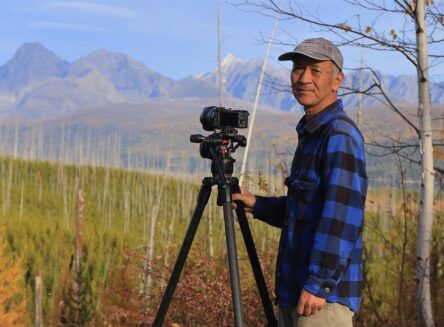
Love of Mountain Goats Drives Glacier Park Photographer Sumio Harada
When the summer crowds of Glacier National Park disperse and snow starts to blanket the peaks, wildlife photographer Sumio Harada reliably treks into the mountains to capture spectacular images of the resident mountain goats.
It’s an animal he has been passionate about his entire career. Harada will share a look back at his career as a wildlife photographer during an upcoming presentation at Flathead Valley Community College. The presentation presented by the Glacier National Park Volunteer Associates will feature behind-the-scenes footage of the “challenges and rewards of wildlife photography.”
Born and raised in Japan, Harada studied Japanese serow as a college student, taking photos that highlighted the many different fur patterns on their faces. Serows are a close cousin of the American mountain goat, which he learned more about in a book called “Never Cry Wolf” by Canadian biologist Farley Mowat, which ultimately influenced him to go study the animals in the Canadian Rockies.
It was during a one-year-long camping trip in Canada that he first heard of Glacier Park by reading “A Beast the Color of Winter” by Whitefish wildlife biologist and author Douglas Chadwick.
“I also met many tourists, they told me ‘you should go to Montana, Glacier National Park is a very nice place to see goats,’” Harada said.
Harada married his wife Kumi in 1989 and the two got their first look at the park when they spent their honeymoon there. He said she enjoys being outdoors and camping, a perfect match for a photographer who is willing to go the extra mile to find the park’s wildlife. The two lived out of their van while Harada was successful in getting great shots of mountain goats.
Soon came along Harada’s daughter, who lived with them in the van. He said the tiny family often called Many Glacier home in the frigid wintertime.
“It was fun but very difficult, the time staying in the van,” Harada said, showing a photo of his wife warming his daughter’s feet at camp. Another photo shows the cart he made to carry his daughter across the snowy landscape, her bundled up in a 90s yellow, blue and pink neon-colored snowsuit. Even though it was cold, they seemed to be having a good time.
These photos were interspersed between some of Harada’s best shots of goats in his early career. One photo shows some 40 mountain goats dotting the rock face of Goat Lick, a location along Glacier National Park’s southern border that is popular with goats due to high concentrations of minerals.
The family moved to Tokyo for two years to save up enough money to return for another trip to Glacier. This time, Harada planned to make a permanent move to Montana, and the stars aligned for him to secure a contract with National Geographic. His photo was featured with an article from Chadwick, the biologist whose work led him to Glacier in the first place.
“He wrote for my picture, so I am proud of that. Chadwick was already very famous with National Geographic as a biologist,” Harada said.
It took many years of hard work, but Harada established himself and his family in West Glacier. They bought a house, but he still spends plenty of time in the park’s snowy backcountry to see what wildlife are up to.
Harada published his first book in 2008, “Mountain Goats of Glacier National Park” which documents seasonal change for the animal. He later went on to publish “Wild Harmony” in 2016, which features many other species of animals in Glacier living alongside mountain goats, with an emphasis on their unique ecosystem.
“All wildlife is connected,” Harada said.
Along with his books and National Geographic, Harada has been published in National Wildlife, Geo, Ranger Rick and Canadian Wildlife, among others.
Harada recently made the switch to focus on capturing video of wildlife in the park. He said he’s getting older — capturing photos of mountain goats during the wintertime is very special to him but he has been doing it for more than 30 years. So, this led him to want to try filming more video, something that can capture the environment of the mountain goat better than a still photograph.
“Wind especially … And they love to play, like jumping, running and sliding on the snow. So, I wanted to record that movement,” Harada said.
He said a television crew with NHK Japan, a public broadcast station, is making a trip to Montana in December to film him for a television special that is set to premiere next fall.
They’ve visited him before to film a wildlife segment in Glacier, and after Harada became friends with the director, he started asking them for advice on filming video. He shared many of his videos with the plan of creating his own film, which led the crew to pitch it for TV. Harada said they’ve come back to film more about his background and how he got into his career of wildlife photography.
Harada will share his experiences of setting up camp in the snowy wilderness, battling freezing temperatures and braving the elements to get the perfect shot during his presentation at Flathead Valley Community College at Arts and Technology Building on Dec. 20 at 7 p.m.
See more of Harada’s wildlife photography on his website www.photorocky.com.